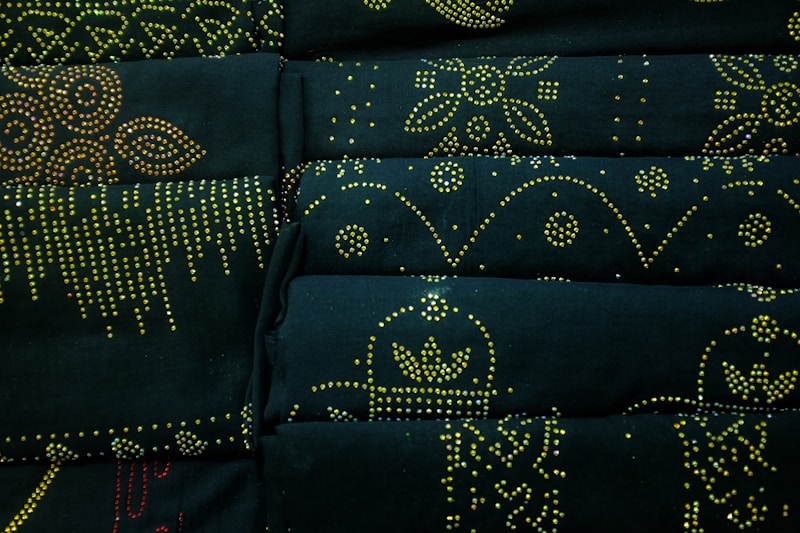Exploring Embroidered Floral Motifs and Fabric Selection: A Comprehensive Guide
Exploring Embroidered Floral Motifs and Fabric Selection: A Comprehensive Guide
Unlocking the Beauty of Embroidered Floral Motifs
Embroidered floral motifs have enthralled designers and fashion enthusiasts for centuries. The charm of intricate floral designs, coupled with a thoughtful fabric selection, can elevate simple garments into exquisite pieces of art. In this guide, we will explore the intersection of embroidered floral motifs and fabric selection, offering you insights, tips, and a comprehensive understanding of how to enhance your wardrobe or design project.
Understanding Embroidered Floral Motifs
Before diving into fabric selection, it’s essential to grasp what embroidered floral motifs entail. These decorative designs are created through the art of embroidery, where threads are stitched onto a fabric to form images or patterns. Floral motifs can range from simple daisies to elaborate rose compositions, each bringing a unique aesthetic. The revival of vintage styles has further popularized these motifs, making them a vital aspect of contemporary fashion.
The Allure of Floral Designs
Floral designs are not only visually appealing but also symbolize growth, beauty, and renewal. Various cultures interpret floral motifs differently, with some flowers representing specific meanings. For example, in Western cultures, roses often symbolize love, while in Eastern cultures, cherry blossoms represent the transient nature of life. Understanding these cultural significances can enhance your connection to the motifs and infuse your projects with deeper meaning.
Choosing the Right Fabric
Choosing the right fabric is crucial when working with embroidered floral motifs. The fabric not only serves as a canvas for your designs but also influences the overall drape and feel of the finished product. Here are some popular fabric options:
| Fabric Type | Pros | Cons |
| Cotton | Breathable, soft, and easy to embroider | Can wrinkle easily |
| Silk | Luxurious and has a beautiful drape | Can be difficult to work with; requires careful handling |
| Denim | Durable and gives a rustic look | Can be heavy with dense embroidery |
| Linen | Natural and breathable; excellent for warm weather | Prone to wrinkles |
Understanding Fabric Characteristics
Every fabric has unique characteristics that can affect the outcome of your embroidered project. For instance, cotton is a versatile fabric that works well for everyday wear, while silk is best suited for special occasions. When selecting fabric, consider the weight, drape, and texture, as they will influence how the embroidered floral motifs sit and flow.

Embroidery Techniques for Floral Motifs
Once you've selected the perfect fabric, it's time to explore various embroidery techniques that can help bring your floral motifs to life. Here are some popular techniques to consider:
- Cross-stitch: A classic technique perfect for creating symmetrical floral patterns.
- Appliqué: Attaching pieces of fabric to create layered floral designs.
- Thread painting: This method allows for more freeform and intricate designs, providing a painterly effect.
- Stumpwork: A three-dimensional embroidery technique that adds depth and texture to floral motifs.
Choosing the Right Thread
The choice of thread is just as important as the fabric selection. Threads come in various materials, colors, and thicknesses. Cotton threads are versatile and widely used, while polyester threads are known for their durability. Silk threads offer a luxurious sheen, perfect for high-end projects. Always ensure that the thread matches the fabric type to prevent issues during the washing process.
Incorporating Floral Motifs into Fashion
Floral motifs have made an impactful resurgence in fashion. From embroidered dresses to jackets, these designs can enhance various garments. When designing a piece, consider the following:
Balance and Composition
The key to beautifully embroidered floral motifs lies in balance. When incorporating motifs into a garment, think about the placement and scale of the designs. Large floral patterns may overwhelm smaller garments, while smaller motifs can add elegance without taking center stage. Additionally, consider how colors complement each other and the overall outfit.
Accessorizing with Floral Motifs
Floral motifs can also be incorporated into accessories such as bags, hats, and shoes. These smaller items can showcase intricate designs and are a fantastic way to play with your style. For instance, an embroidered clutch can be a striking addition to a simple outfit, adding a touch of personality.
Care and Maintenance of Embroidered Fabrics
Once you’ve created a beautiful embroidered piece, it's vital to care for it properly to ensure longevity. Here are some tips:
- Read Care Labels: Follow the manufacturer's care instructions to avoid damage.
- Hand Wash: For delicate fabrics, hand washing is often the safest method.
- Avoid Bleach: Bleach can fade colors and damage threads.
- Iron with Caution: Use a low heat setting and a pressing cloth to avoid damaging embroidered areas.
Final Thoughts on Embroidered Floral Motifs and Fabric Selection
Embroidered floral motifs are a timeless choice that adds beauty and artistry to any fabric selection. Whether you are a designer, seamstress, or a fashion enthusiast, understanding the intricacies of fabric types and embroidery techniques is essential. The right combination can transform simple garments into memorable pieces that express individuality and style.
When exploring the world of embroidered floral motifs, consider not just the aesthetic appeal but also the stories and traditions behind each flower. As you embark on your embroidery journey, remember to have fun, experiment with different combinations, and enjoy the artistic process. With these tips and insights, you're well on your way to creating stunning embroidered floral designs that stand the test of time.
